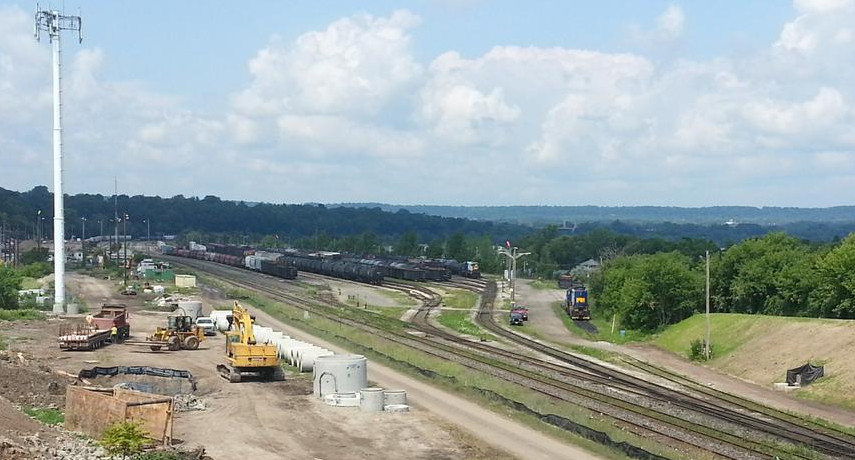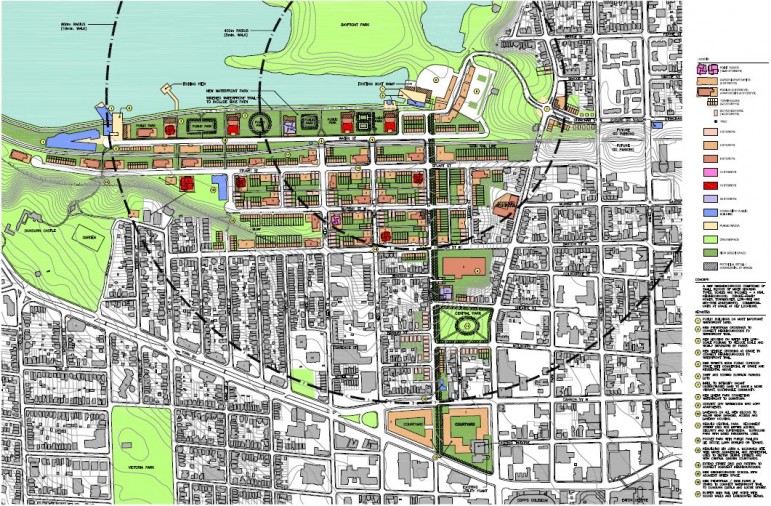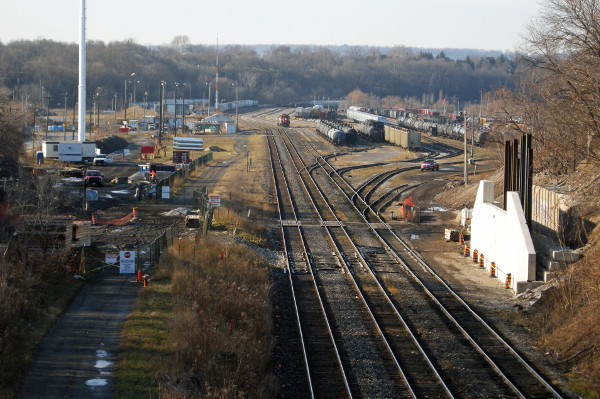The cost of relocating the Stuart Street CN yard is significant, the timeline is likely to be nearly a decade, and funding will require focused leadership at the local level.
By Joey Coleman
Published May 20, 2015
As cities across Canada engage in urban redevelopment and moving disruptive railways, a dormant piece of powerful legislation is returning to the spotlight: legislation which gives Hamilton City Council the power to finally move the Stuart Street marshalling yard along Hamilton's West Harbour waterfront.

West Harbour CN Rail Yard (RTH file photo)
The federal Railway Relocation and Crossing Act (CanLii version) enables municipalities to apply to the Canadian Transportation Agency for an order to move railways and yards - provided the municipality pays and relocation does not harm the viability and finances of the railway.
Relocating the Stuart Street CN marshalling yard was identified as a priority economic development project by the first Council of the new City of Hamilton in 2002 [PDF].

City of Hamilton neighbourhood map with CN Rail Yard
Each successive Council have renewed this priority. Most recently as a key priority in the West Harbour Barton-Tiffany Urban Design Study.
Yet, after over a decade, what little talks have occurred have made no change to the situation.
With US Steel lands for sale as a location to relocate the marshalling yard, City Council is provided an opportunity to act this term to ends ongoing conflicts caused by West Harbour residential and recreation uses abutting the CN yard.
Using the RRCA is not a sledgehammer to a fly situation. It does not preclude reaching a mutual agreement - it sets a clear timeline for the outcome the City is expecting.
The RRCA guarantees Hamilton City Council can fulfill its vision for the West Harbour.
(Credit to Dan Lett of the Winnipeg Free Press whose column introduced me to the RRCA. I strongly encourage you to read the column, as it inspired this post.)

2012 Rethinking Waterfront Concept Neighbourhood Plan by a citizen group
The RRCA's requirements for the City are not onerous and most of the time-consuming work to meet them is already complete. Modifications to the West Harbour Secondary Plan and the Barton-Tiffany Urban Design Study can produce the urban development and transportation plans required.
In 2012, a group of citizens organized, independent of the City, to create their own plans for redevelopment of the CN rail yard, which showed a wide variety of people-friendly uses including residential, entertainment, and parks.
A consultant can write a financial plan for relocating CN to the Stelco lands. With all the documents in place, Council can submit a full application to the Canadian Transportation Agency in 2015.
The RRCA requirements to issue an order are:
The RRCA enables the federal government to fund cost of rail relocation up to 50 percent.

Rail Yard viewed from MacNab during reconstruction of Bay Street overpass (RTH file photo)
The US Steel lands are an ideal location to relocate the rail marshalling yards - it is land located along the CN rail line that does not have any conflicting abutting land uses.
This new location will enable CN to continue their operations without being negatively impacted.
In fact, with better connections to major highways and the ability to build a more modern facility, the new yard could better serve CN's needs and become a leading inter-modal hub that will improve CN's bottom line.
The RRCA was used by the City of Regina in 1987 to relocate CN and CP rail yards, and is presently being used by White Rock in British Columbia to force the relocation of a coastal rail line that is dangerous and frustrating public access to their waterfront.
(The City's "Rail in White Rock" page outlines how disruptive the line has become to the city. This Global News report shows video of the interaction between pedestrians and the railway.)
The City hired Mary-Jane Bennett of the Frontier Centre for Public Policy as a consultant to prepare their application. Bennett's 23-page report to the Council [PDF] outlines the requirements of the Act, costs of relocation in White Rock, and the timelines expected of the process.
White Rock is being closely watched and, if successful, could spur other communities to use the RRCA to force relocation of urban rail lines - especially as the transportation of hazardous goods is a more prevalent concern after the Lac-Mégantic rail disaster that killed 47 people.
/static/images/lac-meganticraildisaster.jpg Lac-Megantic Rail Disaster (Image Credit: Sûreté du Québec/Wikipedia)
A search of the CTA and CanLii databases finds no other cases. Bennett's report states this fact as well.
Winnipeg is the intersection of Canada's railway networks and the lines divide the City. The following map of rail lines in Winnipeg was created by the Winnipeg Free Press:
It costs the City of Winnipeg hundreds of millions of dollars in infrastructure to build bridges and underpasses to ensure traffic flows in the City.
With the recent boom in railway traffic, Winnipeg is looking at a $175-million underpass as its top infrastructure priority.
With grade separation taking priority over other infrastructure needs, Winnipeggers are having a serious discussion of spending $1-billion (yes, billion) to use the RRCA to move cross-Canada rail traffic out of the urban area.
The idea is getting traction because it will save Winnipeg hundreds of millions in planned grade separate road work and create urban renewal opportunities across the City as rail lands are converted to other uses.
The Social Planning Council of Winnipeg wrote an extensive report on moving the railways in 2014, but didn't get as much traction as the current discussion.
The current relocation discussion appears to have originated with Winnipeg business person Art DeFehr who penned an open statement entitled Rail Location in Winnipeg - Think Bold and Big.
It outlines the opportunities that rail relocation provides for Winnipeg. DeFehr's proposal received a positive editorial from the WFP editorial board.
The cost of relocating the Stuart Street CN yard is not insignificant, the timeline is likely to be nearly a decade between the RRCA hearing and relocation, and funding will require focused leadership at the local level.
Some of the costs will be recouped from eventual development of the West Harbour CN lands, and improved land values in the new Tiffany-Barton development area.
Hamilton City Council will need to secure a tripartite funding agreement with the provincial and federal government, will have to prioritize municipal funding within the City budget for many years, and have the patience to create a structure to lead the project over multiple Council terms.
Is there willpower on Council to act on relocating the Stuart Street CN yard? Or will there only be more empty declarations that this is a priority during this term of Council?
First published on The Public Record. Licenced under Creative Commons CC-BY-SA.
By Bryce (anonymous) | Posted May 20, 2015 at 15:30:09
Very interesting idea. If CN sees this as an opportunity to integrate the marshalling yard with the port lands and build an intermodal facility then this doesn't even need to be a contentious move by the city, the RRCA could be a piece of a strong business plan for CN. This is assuming that there is enough demand for a port-to-rail facility.
Curious what the cost to the city would be. Would the increased property taxes make this a profitable venture?
By Haveacow (registered) | Posted May 21, 2015 at 08:26:57
Unfortunately, Hamilton's Port is far too small for a sea-rail intermodal facility. With today's economics you need a super port with the size and container volume like the one south of Vancouver or what is being constructed in Halifax. The great Lakes just don't move enough freight, the ships are just too small. However, a road(truck)-rail interchange is possible if CN is willing to grow the business and the province is willing to provide a large truck only highway connection to a major regional expressway.
By kevlahan (registered) | Posted May 21, 2015 at 11:49:48 in reply to Comment 111678
You don't need an entire truck only highway. A truck only lane on Burlington Street to the QEW would work fine. There is lots of spare lane capacity on Burlington Street and it is only a few minutes from the QEW.
Metrolinx has considered truck only lanes as a way of improving goods movement on congested highways:
http://www.metrolinx.com/en/regionalplan...
And California has at least two highways with truck only lanes:
By ItJustIs (registered) | Posted May 21, 2015 at 09:20:49
Thanks for writing this piece, Joey. A great contribution to the ongoing dialogue.
By jason (registered) | Posted May 21, 2015 at 09:54:27
this is one of the greatest opportunities this city will ever get.
Once we're done with the important things like standing in mailbox holes, and water fountains in stadiums perhaps we can get onto building a city.
Comment edited by jason on 2015-05-21 09:54:43
By this here (anonymous) | Posted May 21, 2015 at 13:53:41
just for someplace to put this: NOW Mag Toronto
Why not make biking on sidewalks legal in the suburbs?
It's a tempting thought. Sidewalks along busier roads in Scarborough have few pedestrians. And it would help us create an instant, low-cost network of bike infrastructure.
by Erhard Kraus
May 20, 2015
6:47 PM
By ItJustIs (registered) | Posted May 21, 2015 at 17:23:03
This law has been around for decades, but not used for over 30 years. The cost of moving the yards is what the major issue is, and not the will or the law.
Suppose that the costs of the move out of West Harbour and the rebuild on the Stelco lands would be around +/- $400 million dollars. And the cost of remediation of the lands to build residential, roads and parks is +/- $50 million, and the cost of servicing the lands (sewers, elect, gas, water, storm etc) would run to +/- $150 million. This comes to around $600 Million.
Even if the Prov/Feds kick in 50% of cost which is $300 million, since the move has to be revenue-neutral for the railway company, the balance of the burden of such a move falls on the city. Resulting in the raising of taxes on the residential base of Hamilton.
The assessment revenues from all the development has to be around $300 million for the city to justify such investments re: recouping the investment. That would take 85,000 units (eighty-five thousand units: comprising of condos/homes/towns/semis/offices/retail etc) at $3500 per unit to recoup the investments made by the city. (Assuming that the Prov/Feds are not seeking any returns on their 50% portion of the investment).
As an example of visualizing the density and built out for 5000 units (i.e 25 towers with 200 units per tower, or a mix of units there off), at $3500/year, per unit of tax revenue for city will bring $17.5 Million per year. It would take --25-- years to recoup $437,500,000 (being about the value of the $300 million + interest/charges of the original 50% of the cost of the move).
Such is the math on such a move.
Assuming the Prov/Feds tomorrow say "OK, so here's the $300 mil...let's see your half." Do Hamilton residents have the stomach for such an investment? Especially in light of the current taxes already making many properties across the city unaffordable for so many seniors on fixed income and younger gens with no job prospects/security...and the investments already committed for the airport lands, Pier 8, the infrastructure deficit and the B-Line LRT and BLAST network?
What are the odds of ANYONE taking the reins here? Slim and none, and Slim just left town.
Comment edited by ItJustIs on 2015-05-21 17:24:15
By kevlahan (registered) | Posted May 22, 2015 at 10:18:53 in reply to Comment 111685
Why $400 million? Why $600 million?
Since the whole point of the calculation is to see what a reasonable estimate for the cost to the City is, and whether it would be acceptable and worthwhile (e.g. in terms of increased tax revenues, economic activity or improving liveability) it is important to start with a fairly accurate estimate of the cost.
If the cost to the city turned out to be $150 million, then the cost to the city would only take 12.5 years to pay off ... thereafter it's pure profit to the city. And that doesn't account for benefits other than tax revenue.
In terms of acceptability, it is important to compare how other cities handled similar development of industrial land. For example, False Creek or Coal Harbour (owned by a railway) in Vancouver, the industrial waterfront in Toronto.
In Vancouver land prices eventually rose high enough that Canadian Pacific itself, through its real estate arm Marathon Realty, redeveloped its lands because they could make more money from development than keeping it as industrial. That could happen here too.
And don't forget that the City has happily spent hundreds of millions of dollars of its own money building the Linc and RHVP with much less direct benefit and at tens of millions in ongoing maintenance each year.
Comment edited by kevlahan on 2015-05-22 10:32:16
By Bryce (anonymous) | Posted May 22, 2015 at 09:49:14
Thanks for chipping in with the math. It's gives some perspective to the scope of the work.
However, on the "benefit" side we should be considering the uplift in the values of the current properties in the Strathcona, Dundurn, and North End neighbourhoods which will generate additional tax revenue.
Considering the investments being made in Pier 8, if additional investments are made on the waterfront where the current railyard is the value of the entire Northwest corner of Hamilton will skyrocket.
You must be logged in to comment.
There are no upcoming events right now.
Why not post one?